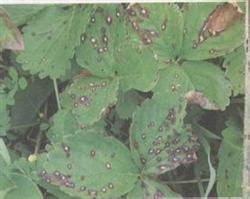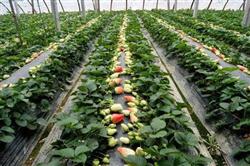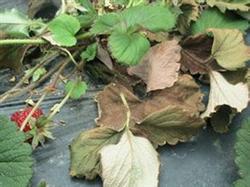Cultivation techniques of watermelon in greenhouse in early spring

1. Preparation before planting (1) Soil preparation: (1) Fertilization. 2000 catties of chicken manure, 80-100 catties of calcium superphosphate, 30 - 40 catties of ternary compound fertilizer, 30- 40 catties of potassium, 1.5 catties of zinc fertilizer and 1.4 catties of boron fertilizer are evenly scattered into the ground according to mu (2) rotary tillage. (3) Trenching. The furrows are 80 cm wide, 1 m apart and 40 cm deep. (4) Fertilization in ditches. Apply fertilizer as above, then rotary tillage. (5) Backfill soil. Fill the trench with soil, 20-25 cm deep. (6) Ridging in furrows. Furrows ridged in the middle, 30-40 cm wide and 15-20 cm high. (b) Open planting points. Spraying herbicide, covering plastic film, planting holes according to plant spacing of 37 cm. (3) Build small arches. Two layers of small arched shed were tied with bamboo chips of 2 meters and 3 meters respectively, and covered with film. (4) Watering. 10-15 days before planting, watering and soil moisture, watering the ridges in the furrows thoroughly. 2. Planting. (1) Planting seedlings age 3 - 5 -40 days, local temperature for 3-5 consecutive days more than 13 degrees began to plant, generally before and after rain. (2) Planting plant spacing 37 cm, row spacing 2.5--, planting 660 trees per mu. (3) Planting in continuous sunny days or cold and warm weather is beneficial to slow down seedlings. (4) When planting, the covering soil should be level with the seedling matrix, and the grafting place should not contact the soil. (5) After planting, pour 1 jin of poison water (600-800 times solution of carbendazim), sprinkle bait around the plant to control mole cricket and other underground pests. 3. Post-planting management. (1) From planting to seedling growth (seedling stage): 1. In order to promote pollen differentiation and increase the proportion of female flowers, the light should be 8-9 o 'clock every day; the temperature should be maintained at 25-35 degrees during the day and 14 degrees at night; the air humidity should be 50%-60%. The seedling stage is not watered, less ventilated, and only ventilated for a short time when the temperature exceeds 35 degrees at noon. (ii) from slow seedling growth to pre-flowering (flowering stage). According to the temperature and humidity in the shed, proper ventilation, temperature and humidity adjustment. The temperature is 24-32 degrees during the day and not lower than 15 degrees at night; the ground temperature is 22-26 degrees during the day and above 14 degrees at night. The relative humidity of air is 50%-60% during the day and 80% at night. During this period, plastic film is mainly used to preserve moisture, soil water holding capacity is 55%-75%, and no watering is allowed as far as possible. In order to improve the quality of watermelon, 70-100 jin of soybean cake and 20 jin of urea are applied to each mu hole when topdressing is applied at planting or cluster stage. (3) From flowering to the peak period of fruit expansion. During this period, the light should be enhanced, and the small arch shed can be removed according to the weather season change. The temperature in the shed is 20-35 ℃ in the morning, 40-45 ℃ at noon, 32-22 ℃ in the afternoon and 20-15 ℃ at night. Air humidity is 50%-60% during the day and does not exceed 80% at night. During this period, combined with watering, fertilizer can be applied twice. After sitting on the melon for the first time, when the egg size of the young melon is large, urea potassium sulfate is applied every mu for 60-70 jin. spray quick-acting chemical fertilizer, microelement fertilize and high-efficiency amino acid compound fertilizer on leaves 15-22 days aft that first crop of melons sits for the second time, spraying once every 6-7 days and continuously spraying twice. After the first crop is harvested, apply fertilizer again to increase the yield of the second crop, and the amount is slightly two-thirds of that of the first crop. During this period, artificial pollination should be carried out, generally at 7-9 a.m., the specific operation method is to pick the male flowers just opened, remove the petals, expose the stamens, hold the male flowers and gently smear them on the stigma of the female flowers, so that the whole stigma sticks with pollen, and a male flower can pollinate 3-4 female flowers. (4) Adjust the plant 1. Pruning, keeping vines and cutting branches. Three vine pruning method, in addition to retaining the main vine, in the main vine 3-5 on both sides of the vine. When the tendrils on both sides are elongated to 20 nodes, the tendrils on both sides are respectively topped to protect the leaf buds of the third or fourth node counted from top to bottom, and the rest are erased. The second female flower of the main vine is retained and the fruit is generally set at about 15 nodes. 5-7 leaves are left after fruit setting to top. (5) Control of weeds 1. Use herbicides to spray the ground before planting to control weeds. The commonly used herbicides are Jindu 'er. 2. Use carbendazim solution (800 times solution) to irrigate roots when planting. After planting, baits should be sprinkled around the plants to prevent underground pests such as mole crickets. The bait is acephate mixed with bran. 4. In case of cold weather during seedling retardation, drought-resistant chemicals such as Tianda 2116 can be sprayed. 5 timely ventilation, so that the humidity in the shed at 50%-60%, not more than 80% at night, if the shed spread a layer of plastic film can also effectively reduce the humidity, this does not create conditions for the spread of diseases. 6. Spraying amisida according to the actual situation to enhance the immunity of plants after seedling retardation. 7. The abnormal phenomenon of watermelon growth should be discovered in time, accurately diagnosed and prescribed. The harvest time of watermelon is more strict when it is harvested in the third maturity period. Watermelon timely harvest, sweet, juicy, colorful, good flavor, single melon weight, storage and transportation resistance. The method of judging watermelon ripeness includes timing and ripeness method. On the day of artificial pollination, a mark is set to determine whether watermelon ripeness is determined by referring to the age length of different varieties. Long-term maturity: 7 to 80 ripeness should be harvested if the transportation period is more than 10 days; 8 to 9 ripeness should be harvested if the transportation period is within one week; 9 ripeness can be harvested if the transportation period is within five days. The best time to harvest watermelon is in the morning or evening, because most of the field heat is emitted after the watermelon is cold at night, and the quality will not decrease due to high temperature and enhanced respiration after harvest, which is not conducive to storage and transportation. The method of harvesting watermelon is to cut it forcefully from the junction between the stem and vine, not to tear it off from the base of the stem.
- Prev

Harm and Control techniques of continuous cropping of Strawberry in greenhouse
1. The harm of continuous cropping of strawberries in greenhouse 1.1 leads to the long-term accumulation of pathogenic microorganisms and continuous planting of strawberries on the same plot, which will cause obvious changes in the microbial community in the soil, and suddenly nematodes and pathogens multiply in large numbers, resulting in the occurrence of diseases and insect pests. 1.2 lead to the loss of strawberry nutrient balance.
- Next

How to control strawberry Fusarium wilt management measures
Strawberry Fusarium wilt is a kind of fungal vascular bundle disease transmitted by soil, which can occur from seedling stage to harvest stage. Prevention and control methods: 1. Strengthen cultivation management. Drain water in time after rain. Diseased plants were found to be removed and destroyed in time, sterilized by spraying drugs, and new high-fat membranes should be added to enhance the efficacy. 2. Flowers and fruits.
Related
- Moge, come on! The staff of the peasant association in the producing area of cantaloupe were frightened when the crowd gathered.
- Causes and Solutions of low Fruit setting rate of Apple
- Symptoms and control measures of passion fruit virus disease
- Fruit growing lesson: how do apple orchards keep high yields?
- Can you build orchards in the mountains? What are the pros and cons?
- How to manage the coloring period of Crisson grape?
- This paper introduces the processing technology of two kinds of fig products.
- How much is a month for retired teachers in rural areas by 2020?
- How can strawberry planting increase sugar content? We should pay attention to management in many aspects.
- What are the cultivation techniques on how to improve the yield of golden fruit?

